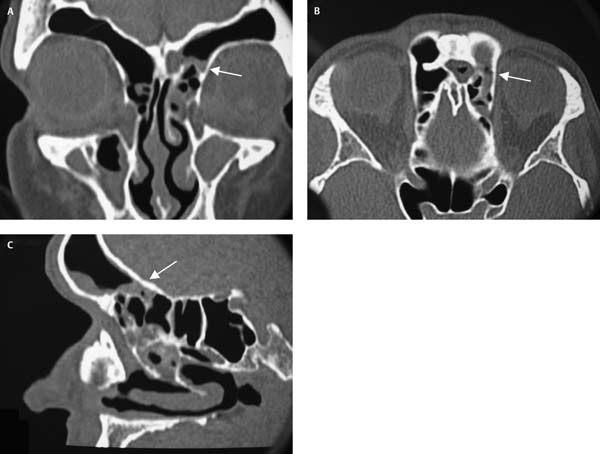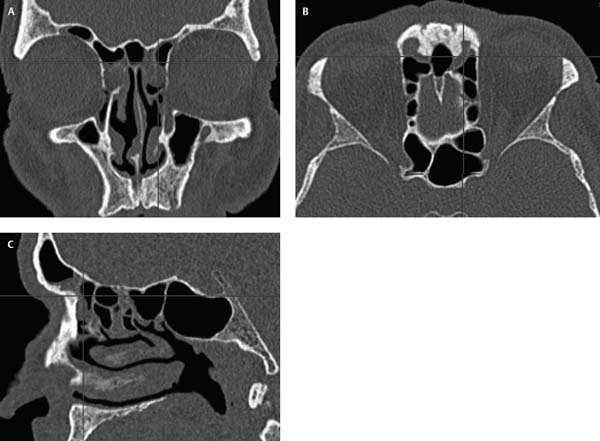3 It is fortunate that the development of endoscopic sinus surgery (ESS) has coincided with major advances in computed tomography (CT) scanning technology. Before CT scanning was available, the extent of sinus disease and the anatomy of the nose and sinuses were assessed on plain X-rays. Plain X-rays are no longer used in this role because they provide neither sufficient anatomical detail nor accurate information on the extent of nasal and sinus pathology. The CT scan has allowed the detailed anatomy of the sinuses to be evaluated and in this textbook CT scans are used extensively to reconstruct the anatomy of the sinuses thus enabling a surgical plan to be made before surgery begins. The surgical philosophy of this textbook is underpinned by the availability of high-quality CT scans in three planes. CT scans are used as an aid for both the diagnosis of chronic sinusitis and for the planning of the surgery. However, there is a significant incidence of mucosal abnormalities seen in completely asymptomatic patients.1 Thus it is important that the patient has undergone adequate medical treatment for the nasal and sinus condition before a CT scan of the sinuses is performed.2 The coronal scan is the primary scan used to assess the anatomy of the sinuses.3 These scans should be sufficiently close together so that an identified cell can be followed from one slice to the next. This allows a three-dimensional (3D) image of the anatomy to be reconstructed from the scans.4–6 The axial scan is of particular value in determining the drainage pathway of the frontal sinus. This is important when deciding where the curette or probe is going to be slid during the dissection of the frontal recess. Our department recently published a study evaluating the value of the parasagittal scan in assessing the frontal recess and in the understanding and planning of the surgery.7 We found that the parasagittal scan significantly improved the surgeon’s ability to assess the frontal recess and improved the understanding of the anatomy by a mean of 57% on a 10–point visual analogue scale. The parasagittal scan also altered the surgical plan for the patient in over 50% of patients studied. We therefore recommend that all patients undergoing ESS should have a high definition helical multislice CT scan of the sinuses with the scans presented in all three planes. An example of the quality of the CT scans that should be expected using this protocol is shown in Fig. 3.1. Good quality CT scans are critical to the ability of the surgeon to reconstruct the anatomy and drainage pathways of the sinuses. Ideally, images should be in the coronal, axial, and parasagittal plane and should be relatively close together so that a cell can be followed from one scan to the next. Our current CT scan imaging protocol on a multislice CT helical scanner requires scans to be performed in the axial plane at 0.5- to 1-mm intervals with coronal and para-sagittal reconstruction. Images in all planes are printed for the surgeon. The windows of the scan are set at between 1500 and 2000 with a center of +100 to +300 for highest bony definition. If there is a suspicion of fungal sinus disease, the window settings are changed to soft tissue settings. This allows the opacified sinuses to be assessed for double densities that are often present in chronic fungal sinus disease. Some CT scanners have software where cursors can be moved through a series of scans in one plane while at the same time the views of where the cursor is in the other planes are simultaneously displayed. Such software can be purchased independently if not available on the scanner (e.g., Voxar, Edinburgh, UK). For owners of Apple computers there are programs (OsiriX) that can be downloaded free from the Internet which accept DICOM images from CT scanners and will create images in all three planes with movable crosshairs. In addition, all computer-aided surgical (CAS) systems also have this facility. With these systems the CT scans can be scrolled in a particular plane and the other views change depending on where the cursor is placed on the scan being viewed. If either the software is available or an image guidance machine is going to be used for a particular patient, it is valuable to utilize this technology to try and get a better understanding of the 3D anatomy of the patient before the patient is operated on. An example of a cursor placed in a position in one plane and then displayed by the computer in the other planes is shown in Fig. 3.2. Fig. 3.1 Computed tomography scans with slices in the coronal (A), axial (B), and parasagittal planes (C). The disease in the left frontal recess (white arrow) can be evaluated and the cellular structure better understood if all three planes are available. A central theme throughout this book is the utilization of high quality CT scans in three different planes to build a 3D picture of the anatomy of the sinuses. In general the coronal scans are viewed first and cells identified and followed in an attempt to build up a 3D picture of the anatomy. This is done in the frontal recess (see Chapter 6) and, after completion of the frontal recess, the process is repeated in the posterior ethmoids and sphenoid (Chapter 8). After the anatomy is reviewed on the coronal scans (Fig. 3.2A), the parasagittal scans are reviewed (Fig. 3.2C). This often helps with the anterior posterior placement of the cells. Finally, the axial view (Fig. 3.2B) is reviewed as this is often helpful for establishing the drainage pathway of the frontal sinus. The building block concept is based around using a single building block for each cell identified in the frontal recess and in the posterior ethmoids. Following placement or stacking of the building blocks, the drainage pathway of the frontal sinus is established. This is of vital importance as it allows curettes and probes to be passed along this drainage pathway and for the cells to be removed from the outflow tract of the frontal sinus and sphenoethmoidal drainage pathway (Chapter 6). The concept of 3D anatomical reconstruction by using building blocks to recreate the anatomical formation in the frontal recess and posterior ethmoids and then to surgically establish the drainage pathways is the central theme of this book.
Imaging in Endoscopic Sinus Surgery
 Computed Tomography Scans
Computed Tomography Scans
The Value of Scans in Three Planes
Scanning Protocol
Three-Dimensional Views and the Concept of Building Blocks
Stay updated, free articles. Join our Telegram channel

Full access? Get Clinical Tree




